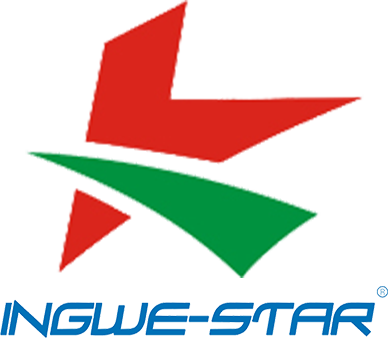The Evolution of Lightbox Displays: From Traditional to Smart LED Technology
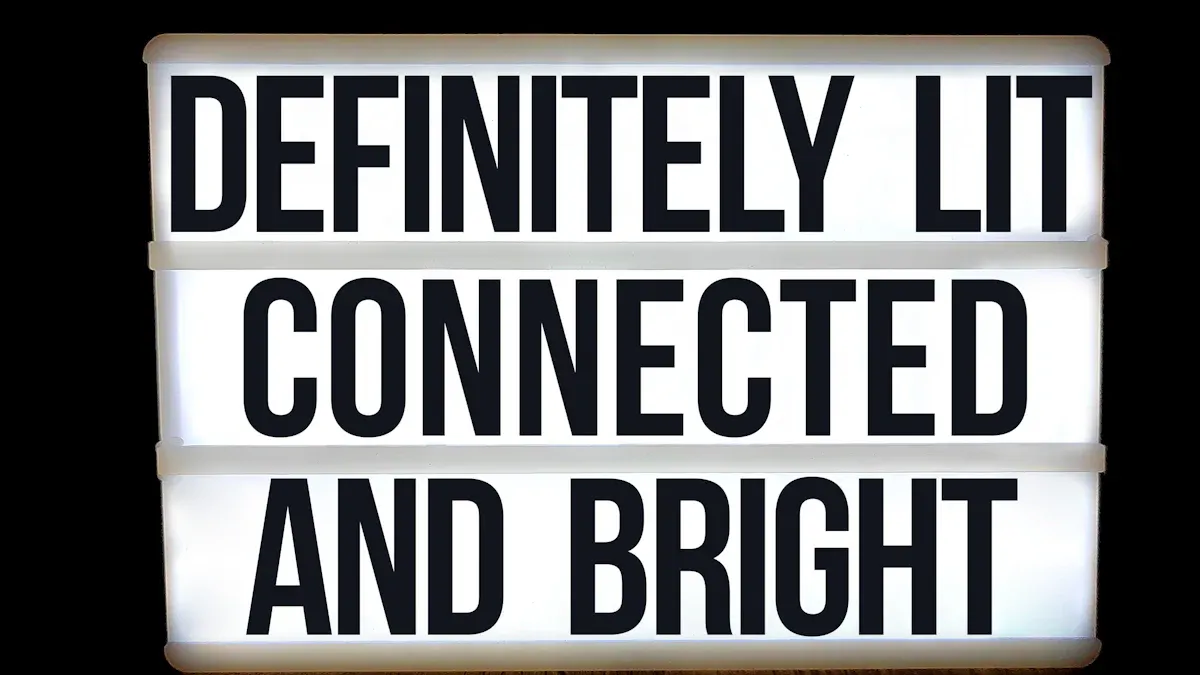
Lightbox displays have changed a lot because of smart LED technology. This new technology is changing how businesses do branding and advertising. Companies and designers now like lightbox solutions that save energy. These solutions can update content in real time and show moving images. The global market for LED lightboxes is growing fast in many places, as shown in the table below:
Region | Market Size 2024 (USD Million) | Market Size 2033 (USD Million) |
|---|---|---|
North America | 1,152 | 1,836 |
Europe | 896 | 1,428 |
Asia Pacific | 864 | 1,377 |
Latin America | 192 | 306 |
Middle East & Africa | 96 | 153 |
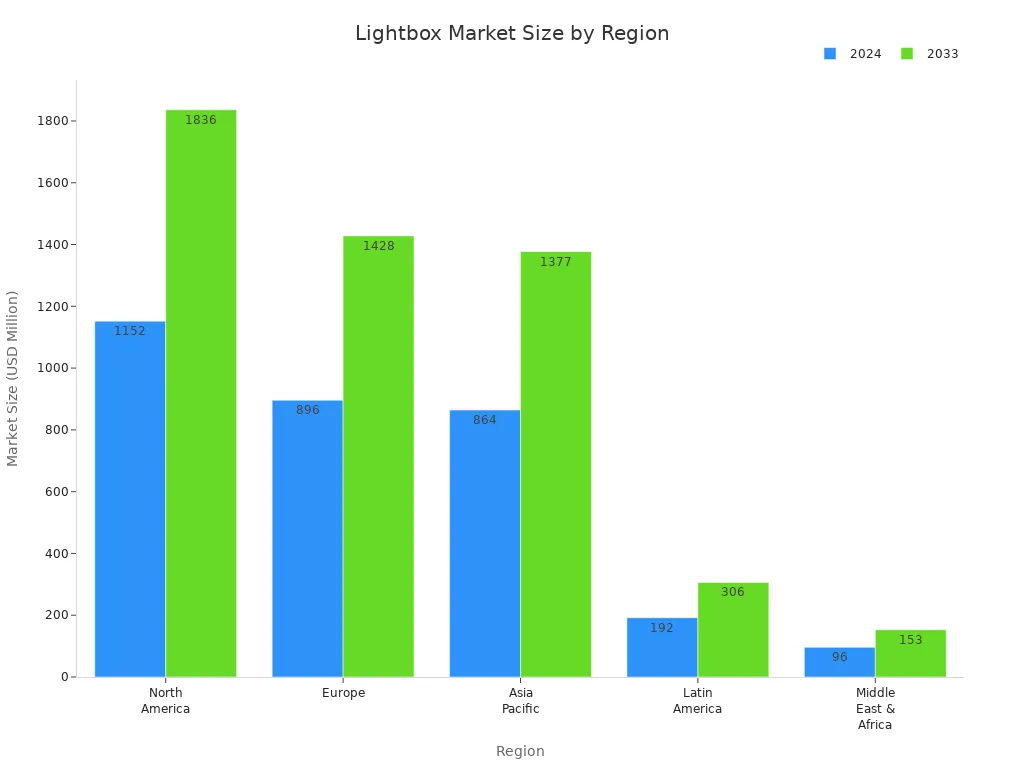
Smart displays have useful benefits. They have fun interactive features and cost less to run. This change in lightbox displays gives new chances for creative ads. It also helps companies reach their sustainability goals.
Key Takeaways
LED lightboxes use less power. They last longer than old displays. They shine brighter and give even light.
Smart LED lightboxes let stores change content from far away. They can add fun features to get more customers.
Backlit fabric graphics make lightboxes lighter. They are easier to move. They show bright, real colors without glare.
LED lightboxes help companies save money. They cut down on waste. They use green materials and smart controls.
Future lightbox displays will use smart tech and data. They will make displays fun, flexible, and personal.
Lightbox Displays: Origins and Basics
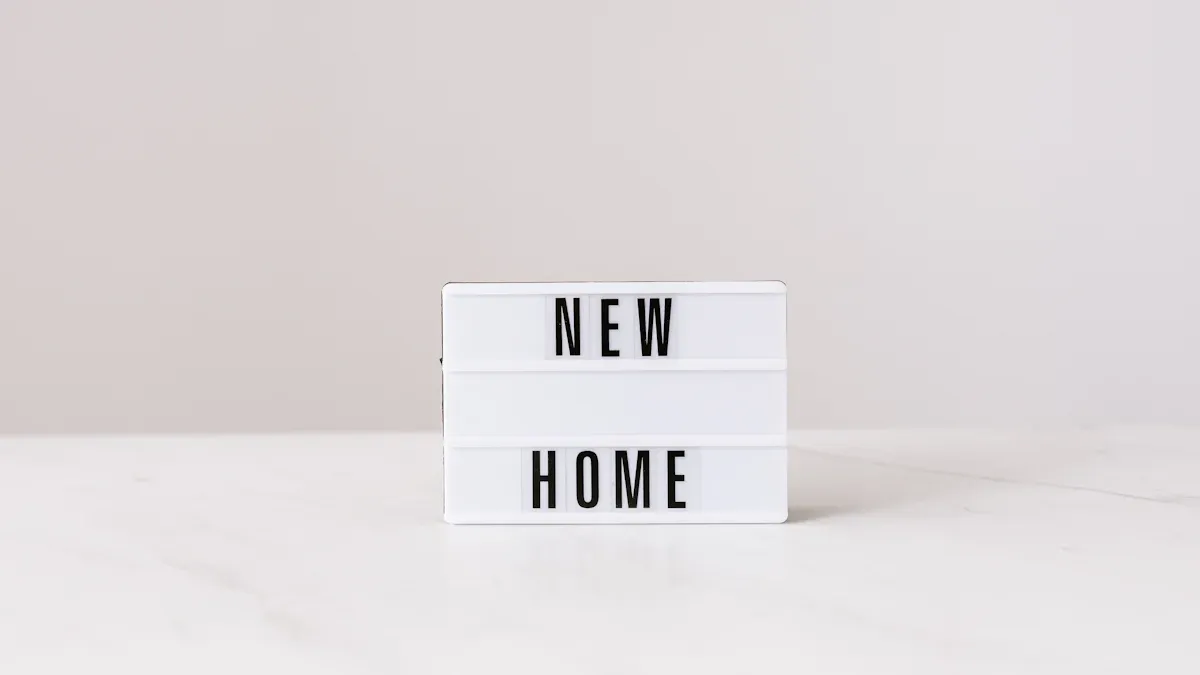
Early Designs
Lightbox displays began as simple tools for workers. People used boxes with lightbulbs inside. They put frosted glass on top of the box. This helped photographers look at slides and films. The frosted glass spread the light evenly. It made details easier to see. Incandescent bulbs gave the light. These early lightboxes made light like daylight. This was important for sorting photos. Later, lightboxes were used in new ways. Doctors used tall panels to look at X-rays. Advertisers used glowing panels to get attention. These first designs led to today’s displays and pop-up displays.
Traditional Backlit Methods
As technology got better, lightbox displays improved. Two main types were made: direct-backlit and edgelit lightboxes. Direct-backlit models had lamps behind the graphic film. This made the display brighter and more even. Edgelit lightboxes had lamps at the sides. The light shined sideways through the panel. This made the cabinets thinner. Sometimes the lighting was not even.
Feature | Direct-Backlit Lightbox | Edgelit Lightbox |
|---|---|---|
Lamps behind the graphic, shining forward | Lamps at edges, shining sideways | |
Brightness | Brighter | Standard brightness |
Uniformity of Light | More uniform | Less uniform, dimmer center in large sizes |
Cabinet Depth | Deeper (2-4 inches) | Thin (less than 1 inch) |
Energy Use | Higher | Lower |
Cost | Higher | Lower |
Size Limitations | Good for large sizes | Less effective for large displays |
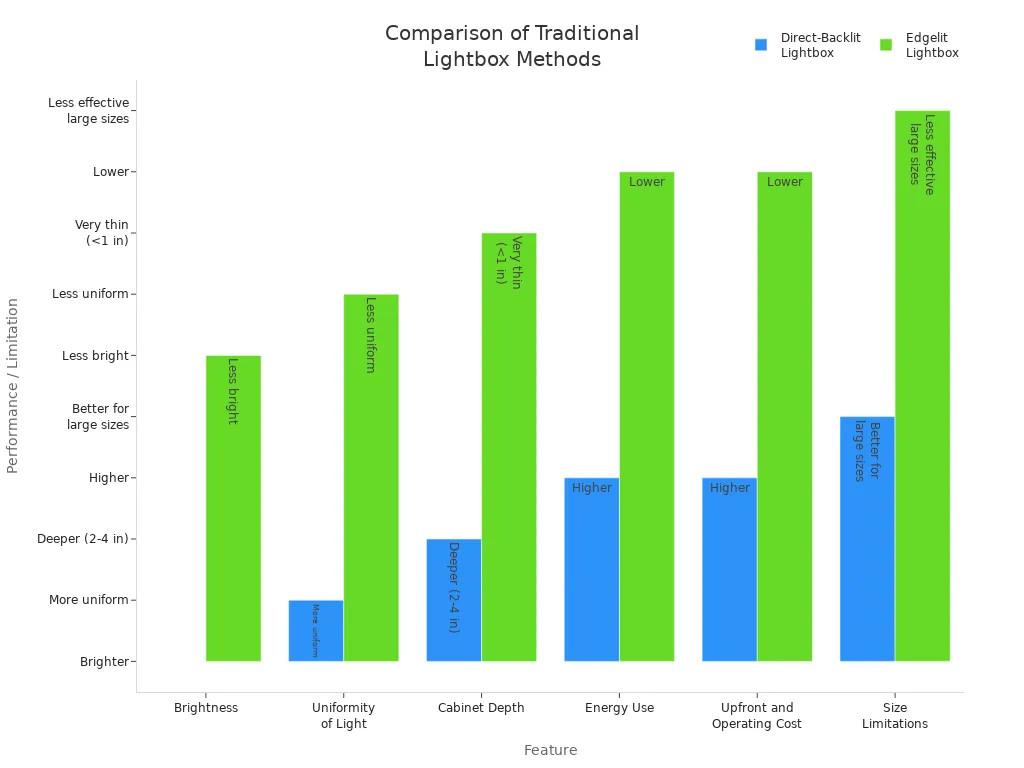
Traditional lightboxes had some problems. The biggest graphic size depended on the materials. Duratrans and polycarbonate sheets set size limits. Sandwich lightboxes worked best for displays under 10 feet. Direct-backlit models cost more and used more power. Their depth made slim designs hard to make. Even with these problems, traditional lightboxes helped create pop-up displays and new lightbox technology.
Evolution of Exhibition Displays
From Static to Dynamic
Exhibition displays have changed a lot over the years. In the past, booths used stands and posters that did not move. People could only look at them from one spot. Pop-up displays made setting up booths much easier. These displays saved time and effort for exhibitors. But they still looked stiff and did not grab much attention.
Things changed when designers added moving parts. Now, exhibitions often have interactive art and moving sculptures. Motors and spinning parts make these displays exciting. Projection mapping is also popular now. It turns flat walls into screens with pictures and videos. Augmented reality lets people see digital images and 3D shapes. LED lighting can change colors and patterns with a program. These updates make exhibitions more fun and easy to remember.
Tip: Dynamic displays help brands get noticed in busy halls. They bring in more visitors and keep people interested longer.
Exhibition displays now use modular tension fabric lightboxes. These systems use backlit fabric and LED lighting for bright displays. Exhibitors can change layouts and use the same parts again. Many new systems use aluminum frames and save energy. This focus on being green fits what businesses want today.
Role of LED Technology
LED technology is very important for exhibition displays. LED panels use small diodes to make bright, colorful images. These panels show clear pictures even from far away. Unlike old projectors, LED displays do not make shadows or glare. They work well in all kinds of light, even bright rooms.
LED displays come in many shapes and sizes. Their design lets people build video walls for any booth. These displays show sharp graphics, live video, and 3D animations. Visitors can touch screens or use motion sensors for more fun. LED systems are quick to set up and keep colors the same everywhere.
LED lighting saves a lot of energy for exhibition displays. Studies show that new LED systems can use half as much power. Programmable controls and dimming save even more energy. LED lighting also makes it easier to see and can help people feel more awake. These benefits make LED displays a smart pick for exhibitions.
LED technology makes exhibition displays brighter, flexible, and cheaper to run. LED systems last a long time and need little care. Exhibitors can now make amazing displays that attract more people and help their business grow.
LED Lightboxes: Modern Advancements
Energy Efficiency
LED lightboxes have made lighting better for everyone. They use much less power than old lightboxes. New LED bulbs often need only 10 watts. Older bulbs can use up to 60 watts for the same light. This saves money on electricity and makes less heat. LED lightboxes also last a long time. Some LEDs work for over 25,000 hours. Businesses spend less on energy and fixing lights. Energy efficiency helps companies lower their carbon footprint. It also helps them meet green goals. Many people pick LED lightboxes to save money and help the environment.
Backlit Fabric Graphics
Backlit fabric graphics make lightboxes lighter and easier to move. The fabric gives bright colors that look even and soft. There is no glare, so images look natural. People can fold or roll the fabric for easy transport. The frames are made from lightweight aluminum. This makes the whole lightbox weigh less than old ones. Setting up is fast because the fabric fits with a silicone strip. No special tools are needed. The graphics stay flat and do not wrinkle, even after many uses. LED lightboxes with fabric graphics show great color and look smooth. These displays are good for big spaces and save money on shipping and setup.
Note: Backlit fabric graphics in LED lightboxes feel soft and look bright. They help displays stand out anywhere.
Color Tunable Features
Color tunable features let people change the color and brightness. This makes displays more fun and flexible. You can set the mood or match brand colors easily. Changing the color temperature helps make the right feeling for any event. These features also help make displays that get noticed. LED lightboxes with color tuning give designers more choices. They help businesses make a bigger impact. This new technology gives more ways to use energy-efficient lighting and modern lightbox displays.
Smart Lighting and Interactivity
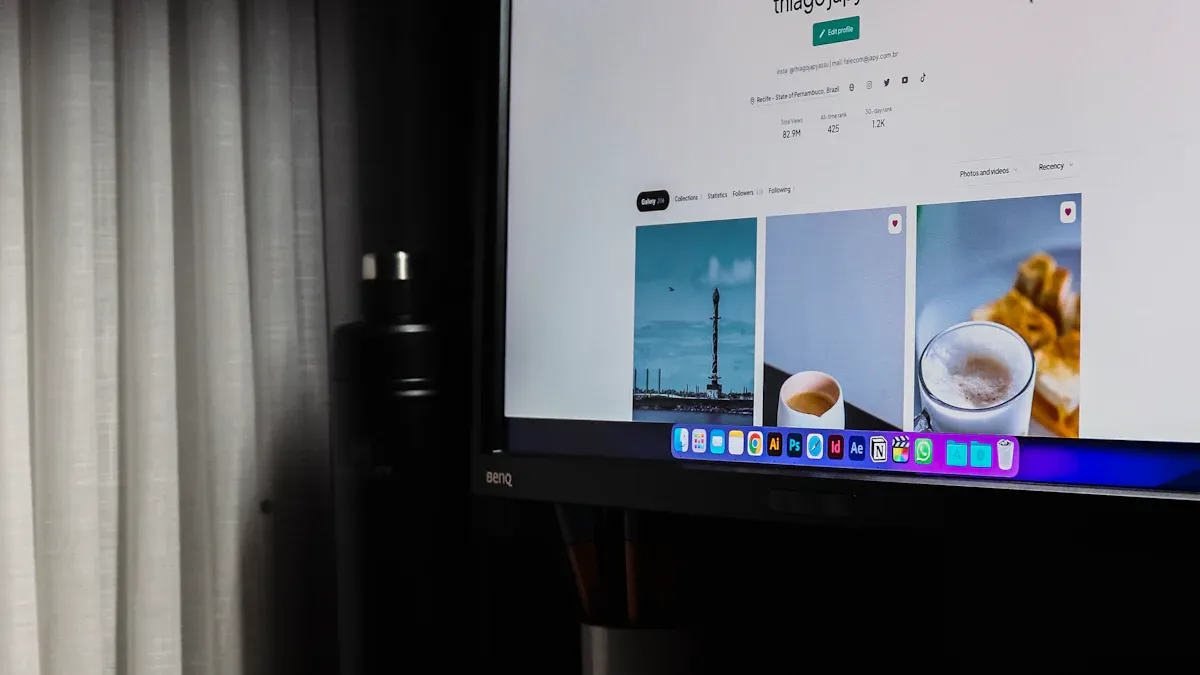
Smart lighting and interactivity have made LED lightbox displays more fun to use. These new features help brands talk to customers in new ways. Now, businesses use smart displays to make their messages pop. They can also learn more about the people who see their displays.
Connectivity
Smart lighting systems in LED lightboxes can connect to digital networks. This means businesses can change what is on the display right away. Store managers can update prices or videos from one computer. They do not have to walk to each display. This saves time and keeps things current.
Many smart displays work with retail systems. If a product goes on sale, the lightbox can show the new price fast. This helps stores keep up with changes in the market. When content updates quickly, customers trust the store more because the info is always right.
Tip: Connected lightboxes help brands keep displays correct and new. People notice when the information is always up to date.
Smart lighting also lets people control displays from far away. Teams can run displays in many places at the same time. This makes it easy to start big sales or show new products. LED lightboxes are thin, so they fit in lots of spaces. Stores can show items in many ways without blocking anything.
Programmable Features
Programmable features let stores plan what shows on their displays. They can set videos or pictures to play at certain times. This makes every visit to the store feel different and fun.
Smart lightboxes use sensors and motion to notice people nearby. When someone walks by, the display can light up or play a video. Some displays have touchscreens or let you wave your hand to control them. Shoppers can tap or swipe to see more or try out virtual products. These features make shopping more exciting and personal.
Touchscreen and gesture controls let people use the display.
Sensors and motion detection notice when someone is close.
Dynamic content changes fast, showing cool animations or videos.
Games and virtual try-ons make shopping more fun and help sales.
Smart lighting lets brands change displays to fit their needs. They can pick the size, look, and what shows on each display. Remote control means updates happen fast, even in many stores at once.
Programmable displays also help stores collect data. They can see which products get the most looks. Stores use this info to make better displays and ads next time.
Note: Smart lighting and programmable features make displays lively and useful. They help brands share stories and connect with people in new ways.
Applications of LED Lightboxes
Retail and Trade Shows
Stores and exhibitors use LED lightboxes to grab attention. These displays come in many shapes and sizes. Some hang on walls, stand alone, or hang from ceilings. Others sit on counters. Portable modular lightboxes help brands set up booths fast at shows. Businesses can change graphics and layouts for each event. Silicone Edge Graphics fabric frames work with LED lightboxes. They show bright and clear images that help people notice brands.
LED lightboxes help stores and booths stand out in busy places.
Backlit fabric displays mix great prints with LED lights for bright pictures.
Portable modular lightboxes fit different booth sizes and shapes.
Pop-up displays turn plain spaces into fun places.
Stores use these displays to show off products and deals. This helps more people see them and get interested. At shows, brands use LED lightboxes as the main part of their booth or add them to other displays. This helps brands make a strong impression and advertise well. Many stores can change what is shown right away, so info is always new.
Stores say they sell more and get more attention after using LED displays. For example, a fancy watch store got more people to look and buy with 3D LED showcases. A clothing shop sold 40% more by using fun pop-up displays.
Hospitality and Public Spaces
Hotels, restaurants, and public places use LED lightboxes to make spaces look nice and share messages. These displays help show off brands and create cool places for guests. You can pick different colors and finishes so lightboxes match the building style.
LED lightboxes help people find their way by showing maps and signs.
Interactive displays, like touch or motion signs, let visitors get info and have fun.
Pop-up displays tell people about events and deals, bringing in crowds.
Portable modular lightboxes are easy to move and use in many ways.
LED lightboxes also show safety tips, like how to stay clean or where to go in an emergency. Staff areas use these displays to share news and keep workers motivated. The color and warmth of the lights can change the mood, like warm lights in spas or cool lights in offices.
Lots of hotels and restaurants use big LED video walls behind desks or in dining rooms. These displays give info, entertain, and help guests feel welcome. They also help with branding and ads.
Sustainability and Longevity
Reduced Power Use
LED lightboxes help companies use less energy every day. They need less power than old lightboxes. This means lower bills and less damage to nature. Many LED lightboxes have smart technology now. These systems can change how bright the lights are. They do this by checking the time or how bright the room is. Smart controls help save even more energy.
LED lightboxes use less power, so costs go down.
They make less pollution than old lighting.
Smart features let lights change with real-time info.
Predictive tools help fix problems before they get big.
LEDs last longer, so there is less waste and fewer replacements.
LED lightboxes last longer than older ones. This means businesses do not have to replace them as often. Over time, companies spend less on repairs and new parts. The long life of LEDs helps save money and is good for the planet.
LED lightboxes are a smart pick for saving energy and helping the Earth.
Eco-Friendly Materials
Modern LED lightboxes use materials that are better for nature. Many makers pick plastics and fabrics that can be recycled. These materials make displays strong and easy to use again. When a display is old, most parts can be recycled. This helps cut down on trash and keeps things out of landfills.
Rules and certifications help make LED lightboxes greener. Standards like ENERGY STAR and EPEAT set rules for energy use and safe materials. Companies must not use harmful stuff and must design products that are easy to take apart and recycle. These rules help brands show they care about the planet and meet green goals.
Certifications like ENERGY STAR and ISO 50001 show a company uses safe materials and saves energy. These standards help the industry get better. They also help customers trust that the products are good for the Earth.
Picking LED lightboxes with safe materials and certifications helps make the future cleaner and greener.
Future of Lightbox Displays
Design Innovations
Exhibition displays will soon have many new design ideas. Smart lighting gives people more control and cool features. Ultra-slim lightbox displays look modern and fit almost anywhere. Designers use frames like snap frames to make changing pictures easy. Many companies want to help the planet by using lights that save energy and materials that can be recycled.
Smart lighting lets you change colors and brightness.
Ultra-slim displays save space and look nice.
Snap frames let you switch pictures fast, no tools needed.
Eco-friendly materials help companies reach green goals.
These new designs help brands make displays that stand out. They also help businesses share new messages and change for each event. In the future, displays will have more custom graphics and work well with other booth parts. Simple styles will show main ideas and keep things neat. Many companies now pick small, easy-to-carry displays for quick setup.
Smart displays that can change will help brands get noticed and support green choices.
Data-Driven Solutions
Data-driven solutions will be very important for exhibition displays. LED lightboxes now connect to digital networks and the Internet of Things (IoT). This lets businesses change what shows on displays right away and control many at once. Sensors in lightboxes collect data on how people use the displays. Companies use this data to make better ads and improve how people feel about their brand.
IoT lets people update displays from far away and save energy.
Sensors watch how customers act and help make better ads.
AI systems change what is shown based on time, weather, or what people like.
Touchscreens and gesture controls make displays more fun to use.
Augmented reality (AR) will be used more often. AR lightboxes let people try products on a screen or see special deals. These features make customers more interested and loyal. Stores use data from these displays to give special offers and keep the right products in stock.
The future of displays will use smart, data-driven ideas to make fun, useful, and personal experiences.
Lightbox displays started as simple boxes with lights inside. Now, they use smart LED technology that saves energy and lasts longer. Businesses like LED lightboxes because they look modern and are easy to set up. These displays help brands stand out and look strong.
Smart LED displays help companies spend less money and make less waste. They also help bring in more customers in different places.
New features let people update displays from far away. Eco-friendly materials make them better for the planet and easier to use.
As technology gets better, will your business try new displays or just do what others do?
FAQ
What makes LED lightboxes better than traditional lightboxes?
LED lightboxes use less power and last much longer. They shine brighter and spread light more evenly. Many businesses pick them to save money and help the earth.
Can someone install an LED lightbox without special tools?
Most LED lightboxes have light frames and snap-in graphics. Many people can set them up with easy tools. Some only need a screwdriver.
Tip: Always read the maker’s instructions for the best results.
How do smart LED lightboxes help with advertising?
Smart LED lightboxes let stores change messages fast. They can show videos, pictures, or new prices. This keeps displays fresh and brings in more shoppers.
Are LED lightboxes safe for long-term use?
LED lightboxes stay cool and use safe parts. They do not get as hot as old bulbs. Many have safety marks.
Look for ENERGY STAR or UL marks for extra safety.
See Also
Understanding The Basics Of LED Light Box Displays
Exploring Upcoming Trends And Innovations In LED Signage
An Overview Of Modern LED Digital Display Technology
